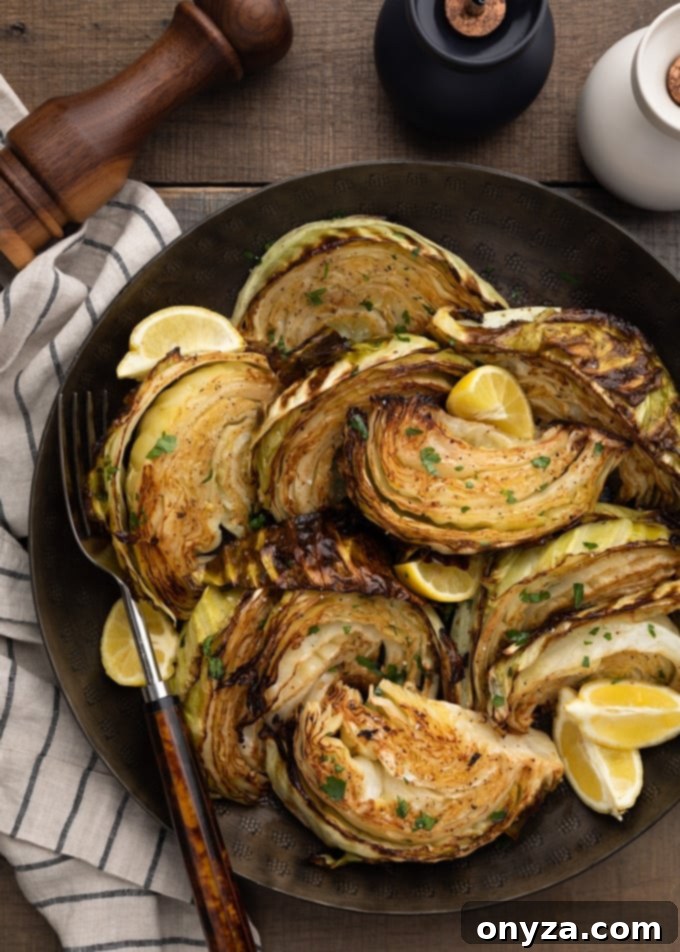Transform your perception of cabbage with this incredibly simple yet profoundly flavorful roasting method! These caramelized roasted cabbage wedges emerge from the oven crispy on the outside, delightfully tender within, and imbued with an irresistible sweetness. Don’t miss the dedicated “Flavor Variations” section below for creative ways to customize this already delicious basic recipe!
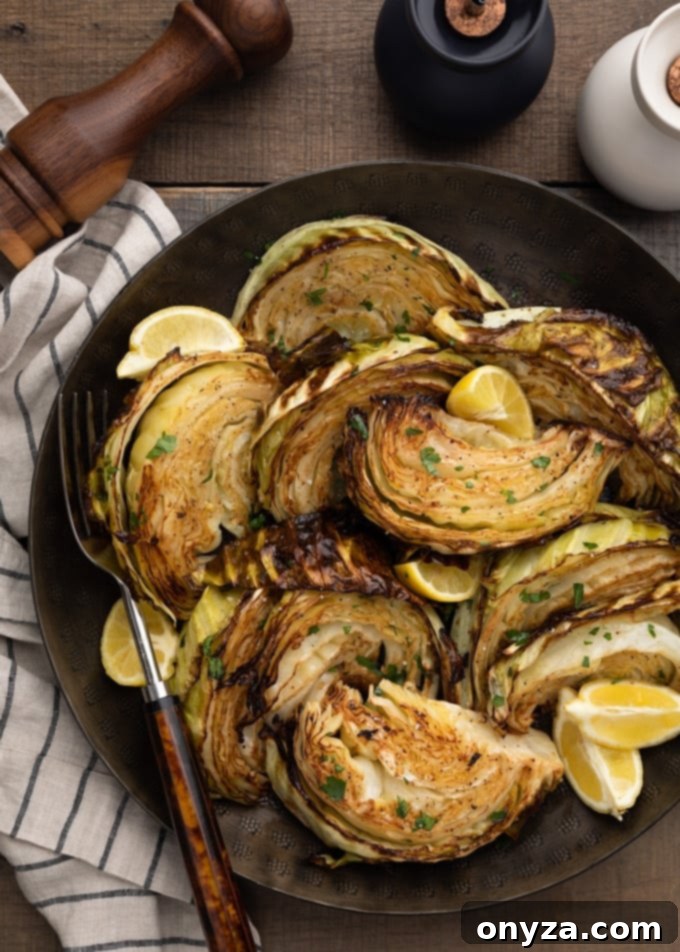
Unlock the Flavor: Why Roasted Cabbage is a Game Changer
For many, the mention of cabbage conjures images of bland, overcooked, boiled greens – a culinary experience that has unfortunately defined this humble vegetable for too long. If you’ve ever found yourself thinking, “Cabbage is just… boring,” prepare to have your mind (and taste buds) completely changed. Roasting cabbage isn’t just a cooking method; it’s a revelation that elevates this cruciferous vegetable from a forgettable side dish to a star on your plate.
Imagine this: the outer leaves of the cabbage develop a beautiful crispiness, bordering on charred perfection, while the interior softens to a buttery tenderness without becoming mushy. The high heat of the oven works magic, triggering the Maillard reaction – a chemical process responsible for browning and the creation of complex, savory flavors. This process brings out a natural, subtle sweetness in the cabbage, transforming its often-understated flavor into something deeply satisfying and utterly delicious. It’s an intensified, caramelized goodness that will make you rethink everything you thought you knew about cabbage.
Whether you’re looking for a healthy, easy side dish to complement a busy weeknight meal, or preparing a festive spread for occasions like St. Patrick’s Day, these roasted cabbage wedges are an effortless upgrade. They offer a depth of flavor and texture that can genuinely steal the spotlight from other components on the table, proving that healthy eating doesn’t have to sacrifice taste. It’s a versatile, budget-friendly, and incredibly flavorful way to enjoy a nutrient-rich vegetable.
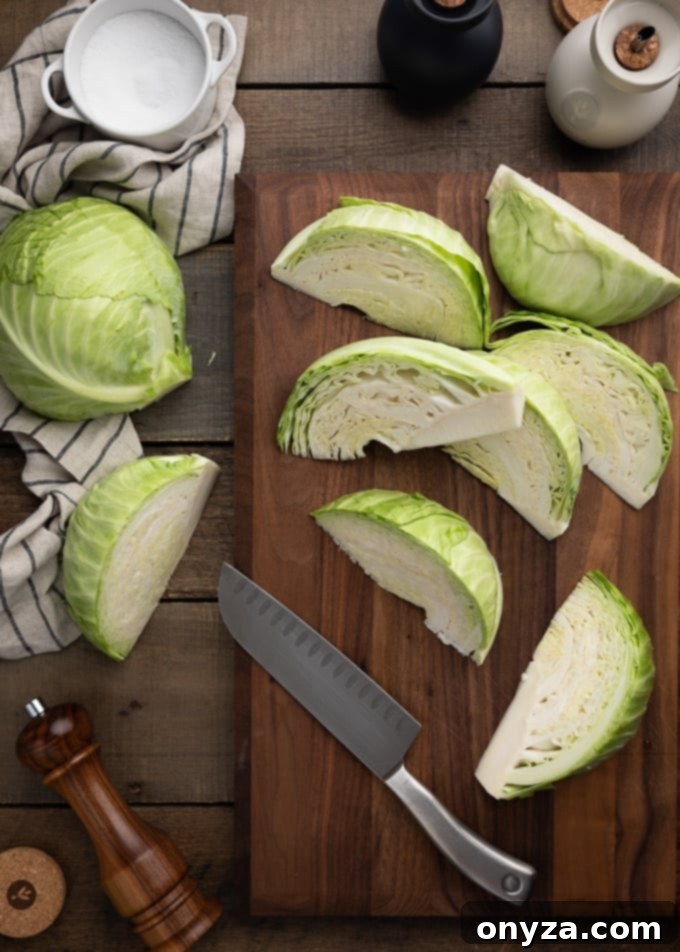
Choosing Your Cabbage: Varieties Perfect for Roasting
Cabbage, a proud member of the Brassicaceae family, shares its lineage with other roasting champions like broccoli, cauliflower, Brussels sprouts, and radishes. This makes it an ideal candidate for high-heat cooking, which brings out its best qualities. The good news is that most varieties of cabbage lend themselves beautifully to roasting, offering slightly different textures and flavor nuances.
While various types are suitable, cooking times may vary depending on whether you choose a heartier, denser variety or a more delicate one. Familiarizing yourself with the options available at your local market can help you select the perfect head for your roasting adventure. This Bon Appetit article provides an excellent overview of different cabbage types.
I typically opt for green or red cabbage for roasting. Both of these varieties feature tightly packed leaves, which means that when cut into wedges, they remain sturdy and hold their shape wonderfully throughout the cooking process. Green cabbage, the most common type, offers a mild, slightly peppery flavor that sweetens beautifully when roasted. Red cabbage, on the other hand, provides a vibrant color and a slightly more assertive flavor, which also mellows and sweetens considerably with caramelization.
Savoy cabbage, with its distinctive crinkled, lacy leaves, is another fantastic option. It boasts a milder, sweeter flavor than green cabbage and an incredibly tender texture. Because its leaves are more delicate and less densely packed, savoy cabbage tends to crisp up more quickly under high heat. If you choose savoy, keep a watchful eye on it during roasting to ensure those beautiful lacy edges char nicely without becoming overly burnt. The goal is a perfect balance of crispiness and tenderness, not incineration.
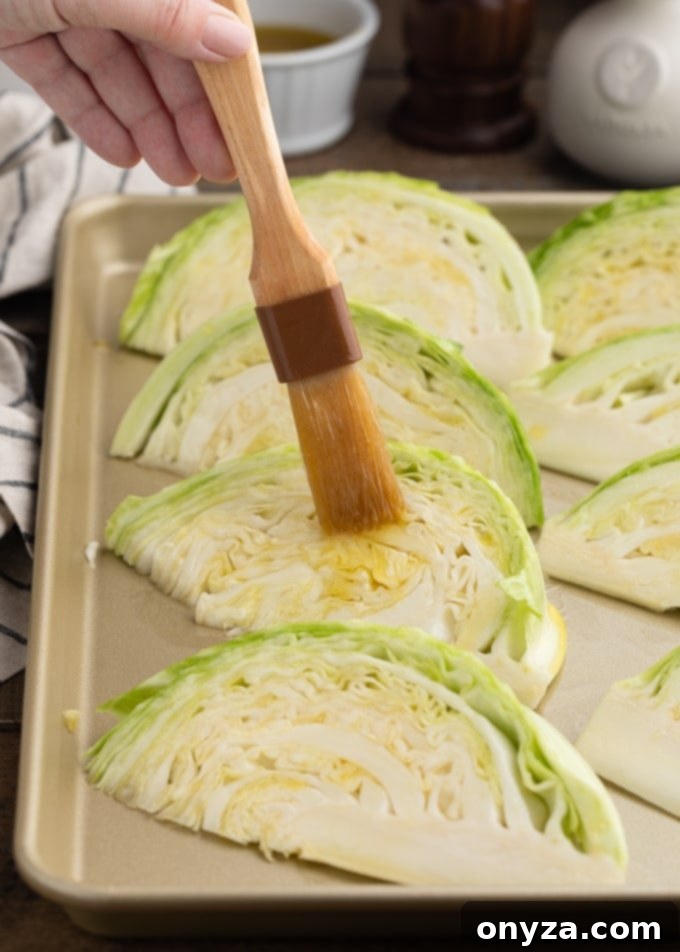
Mastering the Art of Roasting Cabbage
Roasting cabbage to perfection is a straightforward process that yields impressive results. With just a few simple steps, you can transform a humble head of cabbage into a mouthwatering side dish. The key lies in proper preparation and understanding the optimal roasting conditions.
Preparation: The Foundation of Flavor and Texture
When preparing cabbage for roasting, you have a couple of cutting options. You can slice it into round “steaks,” which make for a dramatic presentation, or cut it into wedges, which is my preferred method, especially when serving it as a side dish. Wedges are easy to handle, cook evenly, and present beautifully.
To prepare the cabbage wedges, begin by removing any tough, loose, or wilted outer leaves from the head. These can sometimes have an unpleasant texture or flavor. Next, lay the cabbage on a sturdy cutting board and cut the entire head in half vertically, ensuring you slice right through the core. The core is essential for holding the wedges together during roasting, preventing them from falling apart. Once halved, place each half cut-side down and halve it again, slicing through the core. Finally, take each of those quarters and halve them once more, always cutting through the core. This method will result in eight equally sized wedges, each with a crucial piece of the core attached.
It’s imperative that every wedge retains some part of the core. This acts as a natural anchor, keeping the layers of cabbage intact as they soften and caramelize in the high heat of the oven. Don’t worry about the core itself; it’s perfectly edible and becomes surprisingly delicious and tender once cooked, whether raw or roasted.

The Roasting Process: Achieving Golden Perfection
For optimal roasting, you’ll need a large baking sheet, ideally a half-sheet pan, that allows the cabbage wedges to lay in a single layer without overcrowding. Overcrowding can lead to steaming rather than roasting, preventing the desired caramelization and crispiness. For effortless cleanup, I highly recommend lining your baking sheet with foil or parchment paper.
Seasoning is key to enhancing the cabbage’s natural flavors. I like to keep it simple but effective: brush each wedge generously on all sides with good quality olive oil. The oil not only adds flavor but also helps in achieving that beautiful golden-brown color and crispy texture. Take a moment to allow some of the oil to seep between the cabbage layers; this ensures maximum flavor penetration throughout. Follow this with a liberal seasoning of kosher salt and freshly cracked black pepper.
Preheat your oven to a robust 425 degrees F (220 degrees C). The high temperature is crucial for encouraging quick browning and caramelization. Roasting time will vary slightly depending on the thickness of your wedges and your personal preference for tenderness, but generally, it takes about 25-35 minutes.
To ensure even cooking and browning, I recommend flipping the cabbage wedges after about 15 minutes. Continue roasting for an additional 10-20 minutes, or until the outer leaves have developed a lovely char, the cut sides are deeply caramelized, and the centers are tender yet still retain a slight bite. The transformation from raw to perfectly roasted cabbage is truly remarkable and well worth the minimal effort.
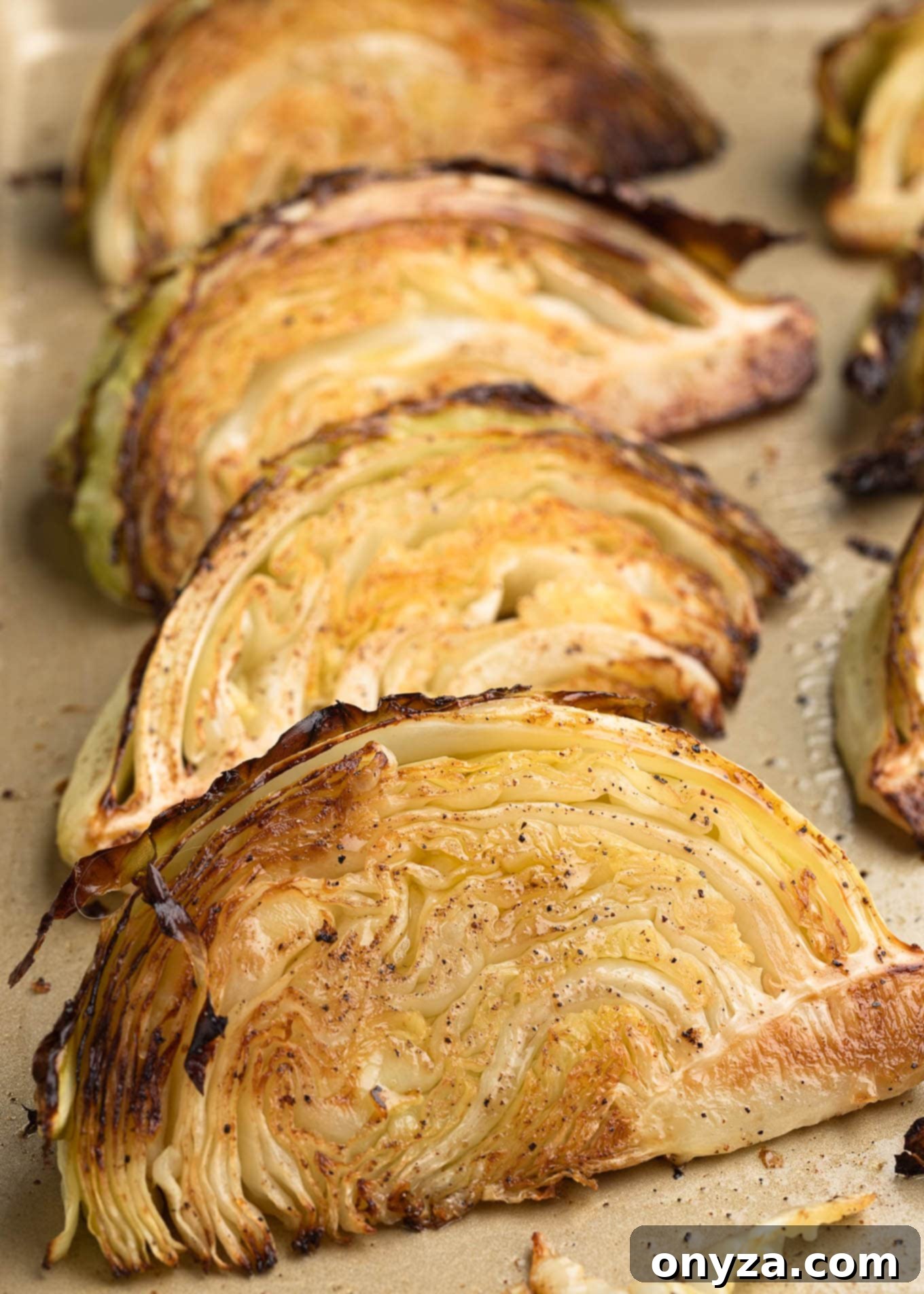
Elevate Your Dish: Creative Flavor Variations for Roasted Cabbage
While simply seasoned roasted cabbage is delicious on its own, its mild flavor makes it an excellent canvas for a myriad of culinary enhancements. After removing the cabbage from the oven, a sprinkle of fresh parsley and a squeeze of bright lemon juice is my go-to finish, adding a burst of freshness and acidity. For those who enjoy a little heat, a dusting of crushed red pepper flakes over the platter provides a delightful kick.
However, the possibilities are virtually endless for dressing up this basic recipe. The best flavoring option often depends on what other dishes you’re serving alongside your cabbage. Here are some of our favorite variations, designed to inspire your own delicious combinations:
- Garlic & Smoked Paprika Infusion: For an aromatic and slightly smoky flavor, whisk 1/2 to 1 teaspoon of garlic powder and/or smoked paprika into the olive oil before brushing it onto the wedges. Alternatively, use your favorite infused olive oil for a quick flavor boost.
- Spicy Chili Drizzle: If you crave extra heat, a generous drizzle of chili oil over the roasted cabbage after it comes out of the oven will provide a vibrant, spicy finish.
- Parmesan Perfection: Immediately after taking the cabbage out of the oven, grate fresh Parmigiano Reggiano cheese over the hot wedges. The residual heat will gently melt the cheese, infusing the dish with a wonderfully salty, nutty, and savory layer of flavor. This pairs exceptionally well with the garlic oil variation mentioned above.
- Sweet & Tangy Accents: For a delightful balance of sweet and tangy notes, consider drizzling the warm roasted cabbage wedges with a homemade Maple-Dijon Vinaigrette. Another excellent choice is a rich balsamic reduction, similar to the one used in my Fig Pizza recipe, which adds a beautiful glaze and concentrated sweetness.
- Asian Inspiration: Transport your taste buds with an Asian-inspired twist. A drizzle of the bright and savory Plum Vinaigrette, featured in my Mandarin Orange Chicken Salad, offers a unique and fragrant flavor profile that complements the roasted cabbage beautifully.
- Crunchy Topping: Add a fantastic textural contrast by sprinkling toasted Panko breadcrumbs over the finished dish. For enhanced flavor, try my Garlic-Parmesan, Spicy Garlic, or Herbed versions from my “Crunchy Toppings” post (originally designed for Mac and Cheese, but equally fabulous here!). Be sure to follow the stovetop toasting instructions for the best results.
- Fresh Herbs: Beyond parsley, experiment with other seasonal fresh herbs to complement your meal. Fresh dill offers a bright, slightly anise-like flavor, while thyme provides an earthy, savory aroma that pairs wonderfully with caramelized cabbage.
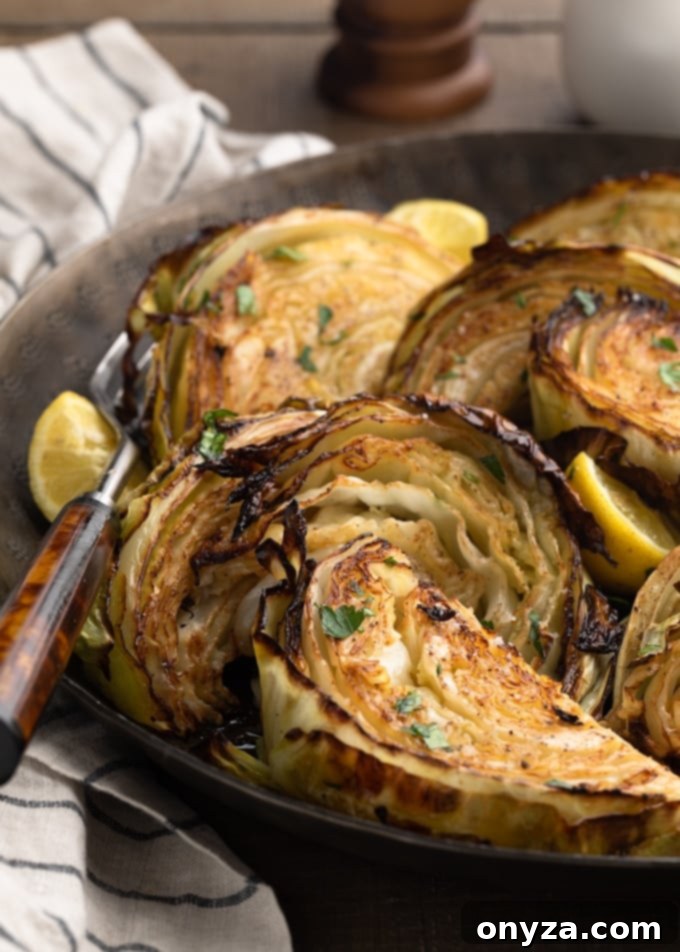
Perfect Pairings: What to Serve with Roasted Cabbage Wedges
The versatility of roasted cabbage wedges makes them an ideal accompaniment to a wide range of main courses, from festive holiday meals to simple weeknight dinners. Their rich, caramelized flavor and tender-crisp texture complement both hearty meats and lighter fare.
If you’re planning your St. Patrick’s Day menu, these roasted cabbage wedges are an absolute must. They are simply fantastic alongside classic Irish dishes such as my Beer Braised Corned Beef, Instant Pot Corned Beef, or Slow Cooker Corned Beef. A quick tip for corned beef recipes: if you’re already cooking your corned beef with vegetables in a pressure cooker or slow cooker, simply omit the cabbage from those recipes and serve these beautifully roasted wedges on the side for superior flavor and texture.
Beyond holiday celebrations, roasted cabbage shines as an everyday side dish. It pairs wonderfully with a perfectly pan-seared steak, complementing its richness with a touch of sweetness. It’s also an excellent partner for savory pork chops, offering a fresh counterpoint to the meat. For poultry dishes, such as my succulent roasted chicken, the cabbage provides a comforting and flavorful vegetable component. Its robust texture holds up well to these substantial main courses.
Don’t underestimate its potential as a standalone meal either! With some of the heartier flavor variations listed above – perhaps a generous grating of Parmigiano Reggiano or a savory garlic-herb infusion – roasted cabbage wedges can easily become a satisfying and healthy meatless lunch, packed with flavor and fiber.
CRAVING MORE? Subscribe to my newsletter and join me on Facebook, Pinterest, and Instagram for the latest recipes and news.

Rating: 5 out of 5 stars from 1 vote
Roasted Cabbage Wedges
by Amanda Biddle
Take your cabbage game to the next level with this simple roasting method! These flavorful roasted cabbage wedges are easy to make, healthy, and delicious.
Prep Time: 10 minutes | Cook Time: 30 minutes | Total Time: 40 minutes
Servings: 8 wedges
Ingredients
- 1 head cabbage (I use green cabbage)
- ¼ cup olive oil
- kosher salt and freshly ground black pepper
- lemon wedges, for serving (optional)
- crushed red pepper flakes, for serving (optional)
Instructions
- Preheat oven to 425 degrees F (220 degrees C). If desired, line a half sheet pan with foil for easy cleanup.
- Remove and discard any wilted or tough outer leaves from the cabbage head. Cut the cabbage into 8 equal wedges.
- Place the cabbage wedges in a single layer on the baking sheet. Brush them on all sides with the olive oil, letting a little bit of the oil seep between the cabbage layers. Season well with salt and pepper.
- Roast for 15 minutes. Carefully flip the wedges, and continue roasting until the cabbage is browned and tender, but still has a bit of bite in the center, 10-20 minutes more. The outer leaves will crisp and get a nice char. Note that roasting times will vary by the size of the head of cabbage.
- Serve with lemon wedges, and if desired, a sprinkling of crushed red pepper flakes for a little kick.
Notes
For other flavoring ideas, don’t miss the Variations section in the article above!
To cut the cabbage into wedges:
Start by cutting the cabbage in half lengthwise, slicing through the core. Then, halve each half, and finally, halve each quarter. Be sure to cut through the core with each slice so all of the wedges contain a little core. This will help them stay intact as they roast. If there’s a large stem on the bottom of the cabbage, you can trim it off, but leave the core intact.
Nutrition Estimate
Serving: 1 wedge | Calories: 88kcal | Carbohydrates: 7g | Protein: 1g | Fat: 7g | Saturated Fat: 1g | Sodium: 21mg | Potassium: 193mg | Fiber: 3g | Sugar: 4g | Vitamin A: 111IU | Vitamin C: 42mg | Calcium: 45mg | Iron: 1mg
Nutrition information is automatically calculated, so should only be used as an approximation.
Please note that our recipes have been developed using the US Customary measurement system and have not been tested for high altitude/elevation cooking and baking.
